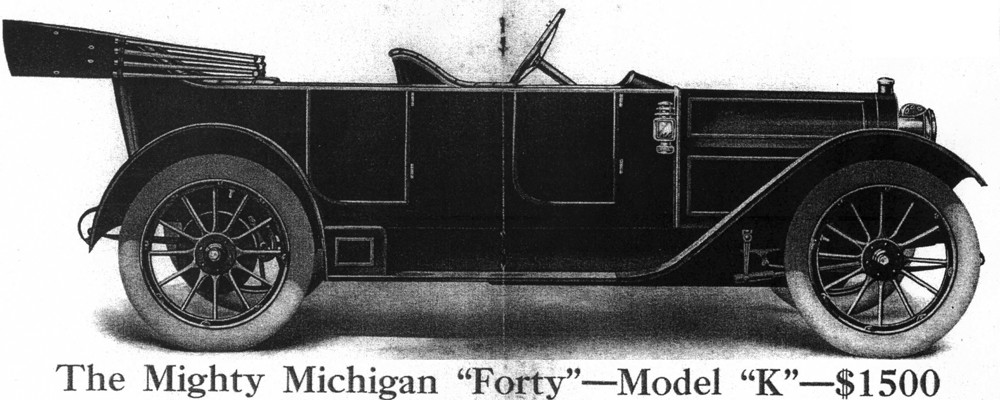Janet & I bought the Michigan in September of 2011, from Steve Dickey – Janet’s cousin. He had intended to finish the restoration of the car started by his father, Philip. But Steve was getting older and was having some serious health issues and knew he wasn’t up to the task. He put out the word among family members that the Michigan was for sale to descendants of Michael Fleck, his great grandfather. The car was nearly 100 years old and Steve wanted to keep it in the family, if possible.
We heard about the old car, but had never heard of a “Michigan” brand automobile. So we did a little research and discovered that the Michigan Motor Car Company (previously the Michigan Buggy Company) was very short lived and the cars were pretty rare. On our next trip to Indiana (July 2011), we made arrangements to meet with Steve at his farm house in Hebron, Indiana to look at the car. That was a pretty fun trip. We were accompanied by Janet’s sister Sally (Elinor Ewen) Davis, her husband Clarence Davis, our son, Eric Correll and his soon to be wife, Kristie D’Ambrosio. All of whom were unofficially working as consultants on the potential purchase. As in, “What are we getting ourselves into.”
The consensus of our group was, “Hey guys, you cannot pass this up. Go for it!”
Janet & I hemmed and hawed between ourselves on what price to offer Steve that was significant but not stupidly high. My seat of the pants guess was that a “do it yourself” restoration would easily involve $50,000. or more in actual costs — not counting any labor. We made an offer to Steve by phone from California and he accepted. We next planned on how to pick up the car and get it secured in our own facility.
Our next trip to Indiana was in September 2011, when we closed the deal with Steve and made arrangements to pick up the car from his barn in Hebron and move it to Sally & Clarence’s barn in Hobart. That story is in the first series of posts in this blog.
Here is what we know about the past history of our Michigan car and its prior owners:
(1) Michael Fleck (the original purchaser)

Michael Fleck, first owner of our 1912 Michigan. Janet’s great grandfather. Seen with the Hobart Volunteer Fire Department. Click on photo to enlarge.
(2) to daughter, Clare Fleck (a.k.a. – Aunt Spot)

Clare Fleck, inherited the car from her father, Michael. Clare was a key member of the Hobart Historical Society.
(3) to niece, Marjorie (Fleck) Dickey –daughter of George Fleck (Clare’s brother) & Marjorie’s husband, Phillip Dickey

Philip Dickey, husband of Marjorie, father of Steve. Philip took the Michigan to his shop class at Portage High School.
(4) to their son, Steve Dickey

Janet Correll & Steve Dickey Sept. 18, 2011, with our “new” Michigan. Both are great grandchildren of Michael Fleck.
(5) to Steve’s cousin, Janet (Fleck/Ewen) Correll & me, Craig Correll, on September 16, 2011
Michael Fleck died in 1949. Clare Fleck died in 1985. Philip Dickey died in 1994. Philip Dickey was a wood shop and industrial arts teacher at Portage High School, in Portage, Indiana from 1954 through 1973. Marjorie (Fleck) Dickey died in 2000. Steve Dickey sold us the Michigan in 2011 and died in 2017.
Apparently Clare Fleck gave Philip Dickey access to the car BEFORE her death. Sometime during that period, the car went to high school, where some good things happened and some mischief was made. The carburetor was attached backwards and the differential ring gear was installed on the wrong side — providing 3 speeds in reverse and 1 gear forward. On the good side of the ledger, the wood interior is very sound. If there were any problems, Philip had them fixed either by himself or his shop class minions. The metal sheathing is remarkably un-dented and straight. The wood supporting the sheathing and forming the body was in spectacularly good shape and painted with thick black paint. The body however, was rough in places — especially the doors which had chips and cracks in the paint. One fender was completely detached and primed with rusty “new” metal welded in. We surmise that the car went to shop classes at Portage High School, sometime between 1954 and 1973. Exactly when this trip to high school occurred, we do not know. In doing a full restoration, it was clear to me that many areas of the car had been touched. Blue silicone sealant was not available in the 1920’s, 1930’s, 1940’s or 1950’s. It would be wonderful to find someone who took a class with Mr. Dickey and find out what work on the car may have been done at Portage High. But for now, it remains a mystery.
My efforts have been to restore the car to its nearly original appearance and good running order. Cars are meant to be driven. Not sit in a museum or glass case. I think I’m 98% there. The remaining 2% is simply unachievable because something will always need maintenance, or break. And we all know that rust never sleeps. So, as long as we are custodians of this car, we will drive it, show it and tell its story.




